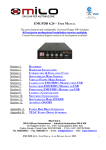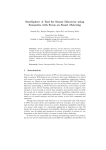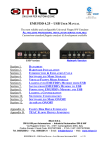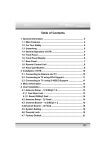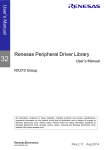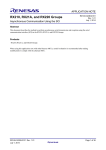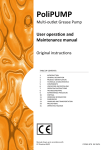Download RX210 Single-phase Two-wire Electricity Power Meter
Transcript
APPLICATION NOTE RX210 Single-phase Two-wire Electricity Power Meter R01AN1212EU0101 Rev.1.01 Dec 03, 2012 Introduction This document provides a guide to designing Electricity Meters with Renesas 32-Bit RX210 microcontrollers. Typical electricity meter designs today use at least one microcontroller an external analog front end (AFE). The role of the AFE is to provide accurate voltage and current measurement data to the metrology computation engine implemented some times in the AFE itself or in the microcontroller firmware. Depending on the accuracy requirements mandated by industry standards and local authorities, additional signal processing tasks such as: phase and temperature compensation, noise reduction through digital filtering and harmonic analysis may be required. Beyond the basic metrology functions smart electricity meters have to be able to calculate and track energy consumption profiles and support automatic meter reading (AMR) through various communication infrastructure such as wireless or power line (PLC) etc. All these additional functions require more computational resources often provided by additional microcontrollers (MCUs) or digital program processors (DSPs). Depending on the features and performance of the MCU’s a high level of integration that can be achieved at greatly reduced cost by reducing the number of components used, design cycle and system complexity. Integrating the AFE function with the computation engine can furthermore reduce the total system cost. Targeting smart meter applications with high levels of integration this application note will explore the capabilities of the Renesas RX210 Group. Smart electricity meters are becoming the standard in many developed countries around the world due to the new demands in accurate energy consumption monitoring, reporting and billing. Depending on the measurement accuracy requirements, the type of information as well as the way the utility companies get this information from the meter, various complexities levels can be expected. Higher accuracy meters use high resolution ADCs or dedicated metrology chips and have extended capabilities in filtering and energy computation. Automatic Meter Reading (AMR) requirements are also differentiating factors and can add levels of complexity that can only be addressed with higher performance devices. Advanced smart meters can cover these high demands by using multiple microcontrollers (MCU) or digital signal processors (DSP). R01AN1212EU0101 Rev.1.01 Dec 03, 2012 Page 1 of 18 RX210 Single-phase Two-wire Electricity Power Meter Contents 1. Energy Meter Requirements ............................................................................................................. 3 2. RX200 Series Description ................................................................................................................. 6 3. Hardware Reference Design using RX210: ...................................................................................... 8 4. Software Reference Design ............................................................................................................ 12 5. References ...................................................................................................................................... 17 Figures Figure 1 Block Diagram Energy Meter ............................................................................................................................. 3 Figure 2 Signal Flow Diagram of Energy Meter ............................................................................................................... 4 Figure 3 Block Diagram of RX210.................................................................................................................................... 7 Figure 4 Reference Design of Energy Meter using RX210 ............................................................................................... 8 Figure 5 Analog Front End for RX210 based Energy Meter ............................................................................................. 9 Figure 6 Software Architecture of Energy Meter ............................................................................................................ 12 Figure 7 Meter Initialization flow chart ............................................................................................................................ 14 Figure 8 Key Press processing Flow Chart ....................................................................................................................... 15 Figure 9 Communication Software Flow Chart ................................................................................................................ 15 Figure 10 Front end signal Processing Flow chart ............................................................................................................ 16 Figure 11 Calculation Software Flow Chart ..................................................................................................................... 16 Tables Table 1 Requirements mapping for Energy Meter.............................................................................................................. 8 R01AN1212EU0101 Rev.1.01 Dec 03, 2012 Page 2 of 18 RX210 Single-phase Two-wire Electricity Power Meter 1. Energy Meter Requirements Block Diagram A typical smart meter system block diagram is shown in Figure 1. This design is based on the wideband sampling technique and uses a single 12-bit SAR ADC to sample voltage and current signal values. The example shows a singlephase two-wire design where one line voltage and one phase current are measured with two of the 12-Bit ADC inputs. A segment LCD module is typically used to display voltage, current, instant power, accumulated energy, power factor etc. Meter reading is supported through a simple optical pulse port or trough more complex IO extension cards for wireless or power line communication technologies. Other I/O functions include push buttons and LEDs for diagnostic and manual controls. External flash memory and EEPROM are used for firmware upgrades and data storage. LCD Display L1 - V Amplifier Filter L1 - I Amplifier Filter Reference Amplifier Filter Temperature Sensor Amplifier Filter KEYPAD USB/ Bluetooth ADC 12 Bit 3.3V Clock Microcontroller EEPROM 120 – 240 VAC Power Management Figure 1 Block Diagram Energy Meter Analog Front End One of the most important parts of an electricity meter is the analog front end (AFE). Depending on the accuracy requirements the AFE can be a high resolution ADC or dedicated metrology chips. The AFE has to also provide filtering and signal conditioning. The design example described in this application note is targeted towards the lower accuracy grades of the 0.5% to 1% classes as specified in the ANSIC12.20. According to the standard for a typical 100A meter the accuracy range is between 1A and 100A. In other words the utilities are interested in accurate energy measurement between 1A and 100A. In order to meet the total meter accuracy of 1% for example the AFE has to have a better accuracy, let’s say 0.7%. Furthermore the 0.7% accuracy is required for the power measurement which is the product of voltage and current. In that case the accuracy requirements for the individual voltage and current will be square root of 0.7 or something around 0.84. To meet the accuracy of 0.84% the ADC needs to have a minimum number of bits called the effective number of bits or ENOB. Equation 1 bellow is used to calculate ENOB and it is based on the dynamic range for the current and the accuracy requirements. ENOB = log2 (Dynamic range / AFE accuracy) Equation 1 The dynamic range is the ratio between the largest current the meter can measure and the smallest one. The largest current in this case is 100A and the smallest one is found from the ANSIC12.20 as 1A. Plugging these numbers in the equation above we get the effective number of bits needed to satisfy the 0.55% accuracy for the ADC. R01AN1212EU0101 Rev.1.01 Dec 03, 2012 Page 3 of 18 RX210 Single-phase Two-wire Electricity Power Meter ENOB = log2 ((100/1) /0.0084) = 13.54 So the effective number of bits for the ADC to accurately measure energy in the 1% class has to be 14 bits effectively. ADC specs are usually listed as resolution and the ENOB is lower due to the contributing error factors such as: quantization error, nonlinearity error etc. As a result the parameter called absolute accuracy should be considered when judging the ADC accuracy. For example a 12-Bit resolution ADC may have an absolute accuracy of 8 bits only due to a total error of +/4 bits. From the example calculation above, we found out that we need an ENOB of 14 bits, so the 12Bit resolution ADC with 8 bit absolute accuracy will not work unless some tricks can be used to increase the accuracy. Luckily there are some ways to improve accuracy through software processing. The target of this application note is not to address accuracy requirements instead it focuses on how the RX210 can support a smart electricity meter application from the hardware perspective. Power Line Interfacing The meter need to measure AC voltage and AC current and depending on the number of phases and configuration it requires from two to eight ADC inputs. The example in Figure 1 shows a single-phase 2-wire topology. Both voltage and current signals need to be measured at the same instance. The line voltage is scaled down using resistor divider to get a signal within the ADC input range. A current transformers (CT) is used to convert the load current to a lower value and shunt resistors are provided to convert to voltage signal proportional to load current. Smart electricity meter applications require accurate input signal measurement and data processing, hence all high accuracy resistors used in the front end. If the current signal is small, a programmable amplifier is used to amplify the signal to use the full dynamic range of the ADC. Signal Flow Figure 2 shows the basic signal flow in a 2-wire Energy meter. The required parameters to be monitored along with the calculations need to be performed are shown. Both voltage and current signals need to be sampled at the same time to do accurate energy measurements. Vin = 0 to Vref Power Line Sample and Hold Temperature Input Signal Characterstics 12-bit SAR ADC (Internal) Reference Vref = 1.5 V (External) Load V1 = 500 mV p-p Load I1 = 500 mV p-p Vref = 1.5 V ADC Input = ± 500 mV for both voltage and current LCD Display Front End Signal Processing Oversampling = x64 Averaging MICRO Single Line - 16 Character LCD with back Lit USB/ ZigBee Calculations need to be performed V (RMS) = √ ((Σ V(t)*V(t))/N) I (RMS) = √ ((Σ I(t)*I(t))/N) P (Active) = Σ I(t)*V(t) S (Apparent) = V(RMS) * I (RMS) Q(Reactive) = √ ((S*S) – (P *P)) PF(Power Factor) = P/S Figure 2 Signal Flow Diagram of Energy Meter Signal Acquisition This design uses a single 12-bit SAR ADC to digitize both voltage and current waveforms. Voltage and Current need to be sampled at the same time to calculate power. This can be achieved if the ADC inputs have a R01AN1212EU0101 Rev.1.01 Dec 03, 2012 Page 4 of 18 RX210 Single-phase Two-wire Electricity Power Meter hardware sample hold circuits. For the hardware which does not have sample and hold, signal processing technique called wideband signaling, can be used to achieve the same result. In this technique samples are taken at a very high scan rate filtered and down sampled (Decimation) to minimize the sample instance error for power calculation. The decimation need to be carried out in software. This process is carried out first filtering the output using a FIR filter for each voltage and current channel and performing the decimation. To improve the overall measurement accuracy, temperature and a fixed voltage reference needs to be measured periodically to track temperature drift and do the necessary corrections. The block diagram shows the technique of using the sample and hold circuits to get voltage and current values at the same instance. Power calculations The meter analog front end measures only line voltage and load current. All the required parameters needed by the energy meter functionality are calculated by using these two values. The essential parameters need to be calculated are RMS voltage, RMS current, Active power, Reactive power, Apparent power, Power Factor and accumulated KWH. These values are calculated over a fixed period of measurement and averaged over before display. The instantaneous energy calculated is integrated to get accumulated power. These calculations need to be performed within the specified time to effectively use the memory usage and greatly improved with hardware FPU and MAC. User Interface The user interface for the energy meter consists of a LCD display and few push buttons to select measured and calculated parameter values on the display. The push buttons are not normally required for the production version of the meter. The LCD display can be a standard one line or two line LCD segment display or a custom LCD glass with user specified display areas and messages. Apart from the LCD display, energy meter need to provide light pulses whose repetitive frequency is proportional to the energy parameter specified. Normally red LEDs are used to generate these pulses. The measurement and calculation software need to have a module which is capable of programming a timer to generate accurate pulses with correct repetitive rate. Communication Interface Smart energy meter need to have communication interface talk to handheld computers and as part of smart grid with the central computers. Smart grid connectivity is generally provided by wireless and to the handheld readers through RS232/RS485 interface. Non-volatile Storage The meter needs non-volatile storage media like Flash device, to store configuration, calibration data, and archived measurement data to provide trending. If the archival is not required then a small EEPROM with 8x1024 bytes may be sufficient. Bigger size flash device is required depending on the requirements of data archival functionality. Power Supply The power supply needs to provide necessary power for the microcontroller and analog front end hardware. Most of the microcontrollers use 3.3V and the analog front end may use 3.3V or 5 V. The power supply needs to take 120 – 240 VAC and generate these voltages with good regulation and low ripple. In addition the power supply need to provide good isolation to protect the equipment connected to the meter using RS232. R01AN1212EU0101 Rev.1.01 Dec 03, 2012 Page 5 of 18 RX210 Single-phase Two-wire Electricity Power Meter 2. RX200 Series Description The RX210 has up to 16 channels of 12-bit successive approximation type ADC suitable to monitor external analog inputs, internal temperature sensor output and internal reference voltages. Three of the channels have dedicated sample & hold circuits with a fast conversion time of 1us. With a performance of 78 DMIPS @ 50MHz operation supported by 32-Bit X 32-Bit single-cycle MAC engine, the RX210 is a very good fit to address not only the sensing needs of most electricity meters but also the computation intensive metrology requirements. Renesas’ unique low-power, zero wait-state MONOS Flash technology allows RX210 MCU to fetch instructions without delay and with minimum power consumption. Competing technology utilizes a high-voltage transistor for readout and hardware accelerators to compensate for a slower Memory Flash, resulting in higher power consumption and decreased performance. Two different types of Memory Flash are available in the RX200: Code Flash for application code, and Data Flash with BGO, which eliminates the need for external EEPROM or to store additional data tables or system data. The BGO (Background Operation) allows the Data Flash to be programmed while code is executed from the Flash. Both Data and Code Flash are programmable at 1.62V, making it possible for battery operated devices to program them while running at minimum operating voltage. RX210 MCU provides six modular hardware subsystems that help products meet safety standards. Clock Accuracy Control checks that the clock frequency is within a predefined range. Oscillation Stop Detection switches the chip’s main clock to an alternative source if the primary one fails. Data Operation Circuit continuously performs a SRAM failure test independently of the CPU. The Independent Watchdog Timer (I-WDT) uses a reliable internal clock source. ADC has disconnect-detection and self-diagnostic functions. I/O pins can read back output values. Main features of RX210 which are suitable for energy meter application are • 32-bit RX processor core with 78 DMIPS @ 50 MHz • Hardware MAC • Zero wait state Flash operating up to 50MHz • 8KB data flash • Built-in 8 channel 12 bit ADC with 1µSec conversion time. • Sample And Hold circuit available on three ADC inputs • RTC with support- for full calendar functionality • Anomaly detection support for system clock failure , flash memory integrity, and ADC self-check A block diagram of RX210 is presented in Figure 3. R01AN1212EU0101 Rev.1.01 Dec 03, 2012 Page 6 of 18 RX210 Single-phase Two-wire Electricity Power Meter Figure 3 Block Diagram of RX210 R01AN1212EU0101 Rev.1.01 Dec 03, 2012 Page 7 of 18 RX210 Single-phase Two-wire Electricity Power Meter 3. Hardware Reference Design using RX210: A reference design of Energy meter using RX210 is shown in Figure 4 and requirement mapping is presented in Table 1. As it can be seen majority of the functionality required is built-in to RX210 microcontroller. Figure 4 Reference Design of Energy Meter using RX210 Table 1 Requirements mapping for Energy Meter Key Requirements LCD Display Keypad RX210 I2C GPIO Connectivity SPI ADC 8-channel 12-bit SAR with 3-channel Sample and Hold Internal Voltage Reference for diagnostics 8 KB Data Flash Hardware MAC helps in implementing signal processing algorithms 3.3V Voltage Reference Non-volatile storage Signal Processing Power Supply External LCD Driver µPD71312 USB Zig-Bee External required for accuracy Smaller EEPROM using I2C 24 V, 5 V Various hardware blocks of the reference design are presented below. R01AN1212EU0101 Rev.1.01 Dec 03, 2012 Page 8 of 18 RX210 Single-phase Two-wire Electricity Power Meter Processor The reference design is using RX210 microcontroller with 32-bit RX processor core. It can deliver 78 DMIPS @ 50 MHz with zero wait state program flash. RX210 has on-chip hardware MAC which greatly assists in signal processing tasks. It supports 128- to 512-Kbyte program flash and 20- to 64-Kbyte RAM. RX210 supports features like Anomaly detection support for system clock failure, flash memory integrity, and ADC self-check which greatly enhance the meter reliability. Measurement interface The reference design supports single phase 2-wire system for energy measurement, which needs simultaneous sampling of both voltage and current signals. Integrated 8-channel ADC in RX210 with sample and hold circuits on three channels, provide this capability. Figure 5 shows the analog front end circuit which is used for power measurement. This circuit converts line voltage and load current in to low level voltage signals that can be digitized by the ADC. A resistor divider formed by R1, R2, R3 and R4 is used to bring down the line voltage to less than 500 mV peak to peak signal. This voltage signal is filtered using a low pass filter (R5 and C1) and AC coupled before adding a DC offset to make the signal within the ADC measurement range. The offset value is equal to the half that of the Vref used by ADC. A current transformer (CT1) and burden resistor (R8) are used to convert high load current in to a voltage signal. To achieve the dynamic range required to get accurate measurement of the load current variation, a programmable gain amplifier is used to amplify the signal. The PGA is programmable using SPI port. Its gain can be set anything from 1, 2, 5, 10, 20, 50, 100, or 200 which gives a dynamic range of 1:200. The PGA reference input is set at the half the value of Vref used for the ADC which makes the output signal compatible with RX210 ADC input. Further, the signal is passed through a low pass filter before connecting to ADC channel 00. RX210 ADC channels 00 and 01 have sample hold circuits which enable simultaneous sampling of the signals. In addition, RX210 has internal voltage reference and temperature sensor. These can be monitored periodically for calibration and temperature drift compensation to improve the accuracy. DC OFFSET ADDITION Vcc L N 117 VAC Voltage Divider R1 R2 Low Pass Filter R6 R3 R5 R4 A01 C2 C1 R7 RX210 SPI Current Transformer Low Pass Filter R8 LOAD BURDEN RESISTOR Programmable Gain Amp PGA113 A00 R9 C3 CT1 Gain =1, 2, 5, 10, 20, 50, 100, 200 Vref/2 Figure 5 Analog Front End for RX210 based Energy Meter Voltage divider for measuring line voltage, is calculated such that high line voltage which 15 % higher than 117 VAC produces 500mV peak to peak signal. Current transformer used has 10A RMS maximum rating and R8 is calculated R01AN1212EU0101 Rev.1.01 Dec 03, 2012 Page 9 of 18 RX210 Single-phase Two-wire Electricity Power Meter from the manufacturer data sheet of the transformer. By using oversampling and averaging, ADC resolution is further increased and noise is reduced. The following estimates the time required for capturing one set of voltage and current values for the RX210 based meter. Total time = tSH + (tDIS× n) + (tCONV × n) + tSHED For single phase meter tSH (Channel-dedicated sample-and hold circuits sampling time ) tDIS (Disconnection detection assist processing time) tCONV (A/D conversion processing time) tSHED (Channel-dedicated sample-and hold circuit sampling-and-holding end time) n ( Voltage and Current) = 30 ADCLK cycles =0 = 50 ADCLK cycles = 2 ADCLK cycles =2 Total Time = 30+100+2 = 132 ADCLK = 2.64 µS @ ADCLK = 50 MHz This works out that effective sample rate is 378 KSPS. Above calculation is for the continuous scan and does not include initial time and diagnostic and temperature scans. Practically 256 KSPS is achievable with diagnostic and temperature scans included. In order to measure up to 19th harmonic, a Nyquist frequency of 2 KHz is required for 50 Hz AC signal. If the specification is modified to limit the bandwidth of the signal to 500 Hz, Nyquist frequency can be reduced to 1 KHZ. The sample rate for x256 oversampling is 256 KSPS, which gives a time 3.9 µS for getting one sample. With a factor of 256 for oversampling and averaging, an improvement of 4 bits can be achieved. This solution enables to get a maximum of 16 bits and closer to achieve the required ENOB to get the accuracy and dynamic range required for the energy meter. This enables the meter to capture energy up to 10th harmonic. The system consisting of front end PGA, low pass filter before ADC, and oversampled ADC with decimation filter as a whole has the better than required dynamic range of 1:100. In addition, the noise is minimized using a 256 tap FIR low pass decimation filter with cutoff at 500 Hz. The only limitation of this design is that it cannot measure energy up to the 19th harmonic but can measure up to 10th harmonic of 50 Hz AC signal. Voltage reference The RX210 does have an internal reference voltage for the ADC but it is only used for calibration. An external reference is provided using a shunt regulator (TL431) for ADC operation. The shunt regulator is used to generate a reference voltage of 2.5V first then 1.25V. This allows the ADC to measure a signal up to 1V peak to peak. LCD Display RX210 does not have on-chip LCD driver or controller. The design uses µPD71312 LCD driver to provide an interface to LCD display. RX210 communicates with LCD driver using I2C bus. µPD71312 requires 400 KHz clock which is generated by RX210 timer. LCD reset functionality is provided by using a GPIO pin. A single line LCD display is connected to the LCD driver for displaying the calculated values. Keypad The key pad is actually consists of individually momentary push button switches. They are connected to different GPIO pins and configured to generate interrupts when key press happens. The key press needs to be debounced before presenting it to the process software. This is accomplished in the software interrupt service routine Non Volatile Memory The RX210 has 8-Kbyte flash memory for storing data (E2 Data Flash). It also provides software controlled protection for the data stored in the flash. Data can be programmed in units 2 bytes or 8 bytes. Erasure is performed in units 128 bytes. RX210 has software library to access the data flash and can be integrated in to the firmware to implement the management of configuration, calibration and archiving data. Power Supply The meter needs to be powered from the line voltage. Isolation from the line is required in order to connect other equipment like computer etc. to the meter. The power supply needs to generate 3.3V required by RX210 microcontroller. A simple transformer less power supply can be used and isolation can be provided using opto couplers on the serial communication interface. This design is cost effective and serves the purpose. R01AN1212EU0101 Rev.1.01 Dec 03, 2012 Page 10 of 18 RX210 R01AN1212EU0101 Rev.1.01 Dec 03, 2012 Single-phase Two-wire Electricity Power Meter Page 11 of 18 RX210 Single-phase Two-wire Electricity Power Meter 4. Software Reference Design The software architecture for the energy meter is shown in Figure 6. The architecture is well suited to be implemented on RX210 microcontroller. The signal acquisition module depends on the type of the front end hardware Application Calculation Engine LCD Driver KeyPad Driver Signal Acquisition Timer Module Data Archiving ADC Driver LED Driver Flash Driver Wireless Stack SPI Driver Hardware Abstraction Figure 6 Software Architecture of Energy Meter Low Level driver routines These are the routines which provide hardware abstraction layer for the meter hardware. ADC Driver The ADC driver allows the full control of the analog front end configuration including sample and hold circuits, ADC channel scanning and transferring ADC data to memory buffer. This also allows configuration for different scan rates for internal temperature sensor and voltage internal voltage reference. LCD Display Driver In the display driver, data to be displayed is transferred to LCD data buffer, then LCD functions will handle display data and map onto appropriate LCD segment. This process includes from top to bottom level functions such as LCD_string(), LCD_putc(), and LCD_MultSegWrite() and so on. The rest of lower level functions are I2C communication interface functions to LCD driver device, µPD71312. Keypad Driver The key switches are configured to generate an interrupt when pressed. The status is captured by the keypad driver after required debouncing and is preserved till action is performed on the key press. The driver provides all the routines necessary for the above functionality LED Driver This driver provides hardware abstraction layer for controlling on-board LEDs through GPIO lines. Flash Driver RX210 has on-board data flash which can be used as non-volatile medium to store configuration, calibration data. In addition it can be used to archive data for presenting trending. This driver provides all the initialization, configuration, read, write, erase routines to use the data flash. R01AN1212EU0101 Rev.1.01 Dec 03, 2012 Page 12 of 18 RX210 Single-phase Two-wire Electricity Power Meter SPI Driver RX210 provides high speed SPI ports for serial communication. These ports are used to support wireless or RS232/RS485 communication capability for the meter by using external hardware. The SPI driver provides all the routines required to configure the data transfer, Send and Receive data using the port. The middleware like wireless stack communicate with the external hardware using this hardware abstraction layer. Middleware These are software modules which provide much of the processing and number crunching in the energy meter application. Signal Acquisition The signal acquisition module captures digitized values of voltage and current in to memory buffer and performs necessary processing before passing the data to calculation engine. To improve ENOB, signal is oversampled and averaging is performed on the captured data in the module. Further simple filtering is done to remove DC value in the input signal. Calculation Engine The calculation engine, which is the heart of the energy meter, performs RMS calculation, instantaneous power calculations and accumulated power and energy calculations. This module may use floating point as well as signal processing algorithms to achieve necessary results Timer Module This module generates accurate pulses whose repetitive rate is proportional to the load energy being measured and takes the input from the calculation engine. It uses the LED driver to control on-board LEDs to generate optical pulse. Data Archiving Energy consumption varies depending on the time of the day and time of the year. If the energy data measured is saved periodically and can be retrieved later for analysis, energy conservation programs can be devised. The data archiving module provides these functionality by saving data to on-board data flash. It also provides routines to access the archived data. Main application program The main application program uses all the drivers and middleware to provide basic Smart Energy Meter functionality. Some of the software included in the application is • Meter initialization code, including system initialization, called before the main() program starts • The main program loop, to initialize the interface devices and displays values in regular interval. • Calling ADC driver subroutines for analog front end device to capture voltage and current values • Calling LCD Display driver subroutines to display values • Calling data archival module routines to save or retrieve configuration, calibration and measured data • Calling other miscellaneous subroutines for basic Smart Electricity Meter application Some of the high level software flow charts are presented in Figure 7, Figure 8, Figure 9, Figure 10 and Figure 11. R01AN1212EU0101 Rev.1.01 Dec 03, 2012 Page 13 of 18 RX210 Single-phase Two-wire Electricity Power Meter Figure 7 Meter Initialization flow chart R01AN1212EU0101 Rev.1.01 Dec 03, 2012 Page 14 of 18 RX210 Single-phase Two-wire Electricity Power Meter Figure 8 Key Press processing Flow Chart Figure 9 Communication Software Flow Chart R01AN1212EU0101 Rev.1.01 Dec 03, 2012 Page 15 of 18 RX210 Single-phase Two-wire Electricity Power Meter Figure 10 Front end signal Processing Flow chart Figure 11 Calculation Software Flow Chart R01AN1212EU0101 Rev.1.01 Dec 03, 2012 Page 16 of 18 RX210 Single-phase Two-wire Electricity Power Meter 5. References 1. 2. 3. 4. 5. Renesas Electronics, RX210 Group User’s Manual: Hardware Renesas Electronics,R01DS0041EJ0090 - RX210 Group Preliminary Data sheet Collins, A., Solid state solutions for electricity metrology, Metering and Tariffs for Energy Supply, Ninth International Conference on (Conf. Publ. No. 462), Aug 1999. Walt Kester, Understand SINAD, ENOB, SNR, THD, THD + N, and SFDR so You Don't Get Lost in the Noise Floor, MT-003 Rev A, 10/08, WK, Analog Devices Inc. Walt Kester, ADC Input Noise: The Good, The Bad, and The Ugly. Is No Noise Good Noise?, Analog Dialogue 40-02, February (2006) R01AN1212EU0101 Rev.1.01 Dec 03, 2012 Page 17 of 18 RX210 Single-phase Two-wire Electricity Power Meter Website and Support Renesas Electronics Website http://www.renesas.com/ Inquiries http://www.renesas.com/inquiry All trademarks and registered trademarks are the property of their respective owners. R01AN1212EU0101 Rev.1.01 Dec 03, 2012 Page 18 of 18 Revision Record Rev. 1.00 1.01 Date Jun 13, 2012 Dec 03, 2012 Description Page — Page 2,6,12 Summary First edition issued Changed: “RX210 series” to RX210 Group on page 1 Changed “RX200 Family” to “RX200 Series” on pages 2 and 6 Fixed broken link on page 12 A-1 General Precautions in the Handling of MPU/MCU Products The following usage notes are applicable to all MPU/MCU products from Renesas. For detailed usage notes on the products covered by this document, refer to the relevant sections of the document as well as any technical updates that have been issued for the products. 1. Handling of Unused Pins Handle unused pins in accord with the directions given under Handling of Unused Pins in the manual. ⎯ The input pins of CMOS products are generally in the high-impedance state. In operation with an unused pin in the open-circuit state, extra electromagnetic noise is induced in the vicinity of LSI, an associated shoot-through current flows internally, and malfunctions occur due to the false recognition of the pin state as an input signal become possible. Unused pins should be handled as described under Handling of Unused Pins in the manual. 2. Processing at Power-on The state of the product is undefined at the moment when power is supplied. ⎯ The states of internal circuits in the LSI are indeterminate and the states of register settings and pins are undefined at the moment when power is supplied. In a finished product where the reset signal is applied to the external reset pin, the states of pins are not guaranteed from the moment when power is supplied until the reset process is completed. In a similar way, the states of pins in a product that is reset by an on-chip power-on reset function are not guaranteed from the moment when power is supplied until the power reaches the level at which resetting has been specified. 3. Prohibition of Access to Reserved Addresses Access to reserved addresses is prohibited. ⎯ The reserved addresses are provided for the possible future expansion of functions. Do not access these addresses; the correct operation of LSI is not guaranteed if they are accessed. 4. Clock Signals After applying a reset, only release the reset line after the operating clock signal has become stable. When switching the clock signal during program execution, wait until the target clock signal has stabilized. ⎯ When the clock signal is generated with an external resonator (or from an external oscillator) during a reset, ensure that the reset line is only released after full stabilization of the clock signal. Moreover, when switching to a clock signal produced with an external resonator (or by an external oscillator) while program execution is in progress, wait until the target clock signal is stable. 5. Differences between Products Before changing from one product to another, i.e. to a product with a different part number, confirm that the change will not lead to problems. ⎯ The characteristics of an MPU or MCU in the same group but having a different part number may differ in terms of the internal memory capacity, layout pattern, and other factors, which can affect the ranges of electrical characteristics, such as characteristic values, operating margins, immunity to noise, and amount of radiated noise. When changing to a product with a different part number, implement a system-evaluation test for the given product. Notice 1. Descriptions of circuits, software and other related information in this document are provided only to illustrate the operation of semiconductor products and application examples. You are fully responsible for the incorporation of these circuits, software, and information in the design of your equipment. Renesas Electronics assumes no responsibility for any losses incurred by you or third parties arising from the use of these circuits, software, or information. 2. Renesas Electronics has used reasonable care in preparing the information included in this document, but Renesas Electronics does not warrant that such information is error free. Renesas Electronics 3. Renesas Electronics does not assume any liability for infringement of patents, copyrights, or other intellectual property rights of third parties by or arising from the use of Renesas Electronics products or assumes no liability whatsoever for any damages incurred by you resulting from errors in or omissions from the information included herein. technical information described in this document. No license, express, implied or otherwise, is granted hereby under any patents, copyrights or other intellectual property rights of Renesas Electronics or others. 4. You should not alter, modify, copy, or otherwise misappropriate any Renesas Electronics product, whether in whole or in part. Renesas Electronics assumes no responsibility for any losses incurred by you or 5. Renesas Electronics products are classified according to the following two quality grades: "Standard" and "High Quality". The recommended applications for each Renesas Electronics product depends on third parties arising from such alteration, modification, copy or otherwise misappropriation of Renesas Electronics product. the product's quality grade, as indicated below. "Standard": Computers; office equipment; communications equipment; test and measurement equipment; audio and visual equipment; home electronic appliances; machine tools; personal electronic equipment; and industrial robots etc. "High Quality": Transportation equipment (automobiles, trains, ships, etc.); traffic control systems; anti-disaster systems; anti-crime systems; and safety equipment etc. Renesas Electronics products are neither intended nor authorized for use in products or systems that may pose a direct threat to human life or bodily injury (artificial life support devices or systems, surgical implantations etc.), or may cause serious property damages (nuclear reactor control systems, military equipment etc.). You must check the quality grade of each Renesas Electronics product before using it in a particular application. You may not use any Renesas Electronics product for any application for which it is not intended. Renesas Electronics shall not be in any way liable for any damages or losses incurred by you or third parties arising from the use of any Renesas Electronics product for which the product is not intended by Renesas Electronics. 6. You should use the Renesas Electronics products described in this document within the range specified by Renesas Electronics, especially with respect to the maximum rating, operating supply voltage range, movement power voltage range, heat radiation characteristics, installation and other product characteristics. Renesas Electronics shall have no liability for malfunctions or damages arising out of the use of Renesas Electronics products beyond such specified ranges. 7. Although Renesas Electronics endeavors to improve the quality and reliability of its products, semiconductor products have specific characteristics such as the occurrence of failure at a certain rate and malfunctions under certain use conditions. Further, Renesas Electronics products are not subject to radiation resistance design. Please be sure to implement safety measures to guard them against the possibility of physical injury, and injury or damage caused by fire in the event of the failure of a Renesas Electronics product, such as safety design for hardware and software including but not limited to redundancy, fire control and malfunction prevention, appropriate treatment for aging degradation or any other appropriate measures. Because the evaluation of microcomputer software alone is very difficult, please evaluate the safety of the final products or systems manufactured by you. 8. Please contact a Renesas Electronics sales office for details as to environmental matters such as the environmental compatibility of each Renesas Electronics product. Please use Renesas Electronics products in compliance with all applicable laws and regulations that regulate the inclusion or use of controlled substances, including without limitation, the EU RoHS Directive. Renesas Electronics assumes no liability for damages or losses occurring as a result of your noncompliance with applicable laws and regulations. 9. Renesas Electronics products and technology may not be used for or incorporated into any products or systems whose manufacture, use, or sale is prohibited under any applicable domestic or foreign laws or regulations. You should not use Renesas Electronics products or technology described in this document for any purpose relating to military applications or use by the military, including but not limited to the development of weapons of mass destruction. When exporting the Renesas Electronics products or technology described in this document, you should comply with the applicable export control laws and regulations and follow the procedures required by such laws and regulations. 10. It is the responsibility of the buyer or distributor of Renesas Electronics products, who distributes, disposes of, or otherwise places the product with a third party, to notify such third party in advance of the contents and conditions set forth in this document, Renesas Electronics assumes no responsibility for any losses incurred by you or third parties as a result of unauthorized use of Renesas Electronics products. 11. This document may not be reproduced or duplicated in any form, in whole or in part, without prior written consent of Renesas Electronics. 12. Please contact a Renesas Electronics sales office if you have any questions regarding the information contained in this document or Renesas Electronics products, or if you have any other inquiries. (Note 1) "Renesas Electronics" as used in this document means Renesas Electronics Corporation and also includes its majority-owned subsidiaries. (Note 2) "Renesas Electronics product(s)" means any product developed or manufactured by or for Renesas Electronics. http://www.renesas.com SALES OFFICES Refer to "http://www.renesas.com/" for the latest and detailed information. Renesas Electronics America Inc. 2880 Scott Boulevard Santa Clara, CA 95050-2554, U.S.A. Tel: +1-408-588-6000, Fax: +1-408-588-6130 Renesas Electronics Canada Limited 1101 Nicholson Road, Newmarket, Ontario L3Y 9C3, Canada Tel: +1-905-898-5441, Fax: +1-905-898-3220 Renesas Electronics Europe Limited Dukes Meadow, Millboard Road, Bourne End, Buckinghamshire, SL8 5FH, U.K Tel: +44-1628-651-700, Fax: +44-1628-651-804 Renesas Electronics Europe GmbH Arcadiastrasse 10, 40472 Düsseldorf, Germany Tel: +49-211-65030, Fax: +49-211-6503-1327 Renesas Electronics (China) Co., Ltd. 7th Floor, Quantum Plaza, No.27 ZhiChunLu Haidian District, Beijing 100083, P.R.China Tel: +86-10-8235-1155, Fax: +86-10-8235-7679 Renesas Electronics (Shanghai) Co., Ltd. Unit 204, 205, AZIA Center, No.1233 Lujiazui Ring Rd., Pudong District, Shanghai 200120, China Tel: +86-21-5877-1818, Fax: +86-21-6887-7858 / -7898 Renesas Electronics Hong Kong Limited Unit 1601-1613, 16/F., Tower 2, Grand Century Place, 193 Prince Edward Road West, Mongkok, Kowloon, Hong Kong Tel: +852-2886-9318, Fax: +852 2886-9022/9044 Renesas Electronics Taiwan Co., Ltd. 13F, No. 363, Fu Shing North Road, Taipei, Taiwan Tel: +886-2-8175-9600, Fax: +886 2-8175-9670 Renesas Electronics Singapore Pte. Ltd. 80 Bendemeer Road, Unit #06-02 Hyflux Innovation Centre Singapore 339949 Tel: +65-6213-0200, Fax: +65-6213-0300 Renesas Electronics Malaysia Sdn.Bhd. Unit 906, Block B, Menara Amcorp, Amcorp Trade Centre, No. 18, Jln Persiaran Barat, 46050 Petaling Jaya, Selangor Darul Ehsan, Malaysia Tel: +60-3-7955-9390, Fax: +60-3-7955-9510 Renesas Electronics Korea Co., Ltd. 11F., Samik Lavied' or Bldg., 720-2 Yeoksam-Dong, Kangnam-Ku, Seoul 135-080, Korea Tel: +82-2-558-3737, Fax: +82-2-558-5141 © 2012 Renesas Electronics Corporation. All rights reserved. Colophon 2.2





















